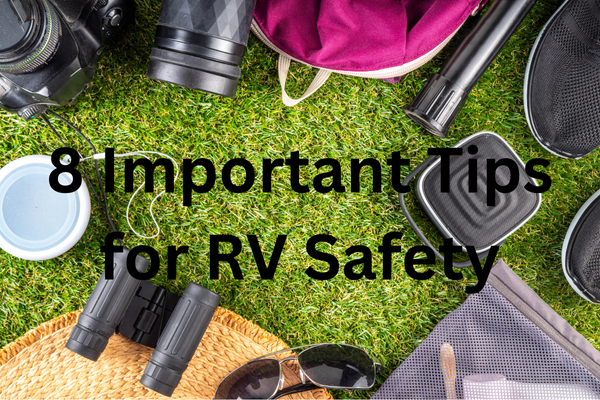

When planning an RV trip, we tend to think about all the fun aspects. Packing the portable grill, bikes, and foldable camping chairs, along with necessary items for a well-prepared outing is usually what we focus on before hitting the open road.
While focusing on adventure and fun is key, keeping safety in mind is just as important. With nearly 11 percent of U.S. households being listed as RV owners, along with an estimated one million Americans living in their RV year-round, accidents are bound to occur.
Making sure you and your passengers are protected is of the utmost importance. This article gives some guidance for ensuring a safe trip. Here are eight important tips for RV safety.
- Before You Go
Plan the trip in advance. Check the destination’s website for any last-minute weather advisories or closures. The day before your trip, or even the morning of, check weather radars for multiple places between your start and finish locations to ensure clear skies for driving.
Additional safety suggestions here include having contact information for the location you are headed to. Don’t rely solely on the internet and Google maps, but have phone numbers, reservation numbers, and contact information on hand.
Hang a whiteboard near the door of your RV for easy visibility. For each trip, change the information to include your campground address and campsite number. Having this information on hand in the off chance of an emergency will help you to provide the exact address of your location.
The night before, fuel up the rig fully and do a safety check. Check road conditions and weather patterns for the route you’ve chosen and make any last-minutes changes to the path you will be driving. There are a variety of apps that provide road updates in real time.
Ensure a fully packed first aid kit is ready to go.
Have a variety of tools packed in a cabinet, in case of minor repairs that might be needed throughout the trip.
Some items to keep in the safety kit include:
- Jumper cables
- Electrical tape
- Spare batteries
- Flashlights
- Portable cellphone chargers and battery chargers
- Fire extinguishers
- Extra oil and fluids
- Tire pressure gauge
- Collapsible shovel
- A variety of screwdrivers, wrenches, etc.
Make sure your insurance and warranty papers are in the glovebox or another easily accessible location, along with the vehicle registration. Have a list of emergency contacts and medications for all passengers. In addition, if traveling with dogs or cats, bring along their vet records.
- Follow the Numbers Rule
This is a good guide to follow and is easy to remember. The rule of thumb is to keep a day’s travel under 300 miles, and arrive at your destination prior to 3:00 p.m. The third part of the 3/3/3 rule suggests staying at your destination for at least three days.
Another suggestion for travel includes stopping every two hours and taking a 15-minute break outside the RV. This is especially true for those traveling with fur babies. Letting the dogs out of their crates or cages to move around a bit is most welcoming to them.
If the 3/3/3 rule isn’t for you, a similar rule of thumb is the 4/4/4: drive 400 miles or less daily, arrive at your resort or destination by 4:00 p.m., and remain camping at the destination for at least four days.
Need less time at a destination? Then downgrade driving times with the 2/2/2 rule. Pushing yourself too much to hurry and arrive may come naturally, but know your limits, and when you start to feel tired or restless, pulling over at the next exit for a truck stop rest is a smart choice.
These three variations give a general travel guideline, but outside of them, a specific stopping plan is to get 45 minutes of non-driving time in throughout a 4.5-hour period.
- Keep Those Seatbelts Fastened
While the motorhome or towing vehicle is moving, passengers should be in their seats with safety belts on. Although kids and pets might want to be up and moving around a motorhome while traveling, keeping them in their seats (or pet crates) is for their own safety. And for yours. Kids and pets can be distracting, and their movements might cause you to take your eyes off the road for a longer period of time. In addition, passengers who aren’t seated and buckled in could be breaking the law depending on what state you are in. Some states require seatbelts to always be worn.
Allowing someone to sleep in an RV bed while you are driving is unsafe, and illegal in states with seatbelt laws, and should be avoided.
- Keep your Distance
Since RVs are heavier vehicles, it stands to reason that they would need more stopping time. Allowing more time to slow down and gradually stop is imperative. Brake gradually to ensure a smooth process, and if you are towing an RV, keep in mind brake fade actions.
- Be Cautious when Changing Lanes
Let the wireless observation camera screen be your guide. Or, use the old-school method of checking side mirrors often before changing lanes. Check regularly to ensure there are no vehicles in the blind spot. As with making turns, allow extra time to cautiously merge into the inner or outer lane of traffic.
- Set the Alarms
Installing and maintaining smoke alarms and carbon monoxide (CO) alarms within the RV is most important. Place the alarms near the kitchen and/or sleeping areas and remember to check them before each trip, along with changing batteries regularly.
- Monitor the Monitors
Tire pressure monitors are great to rely on, simply because you can learn of problems before they cause an issue or damage. One of the tire monitors to consider purchasing includes a sensor that is placed within the tire and a remotely based digital display of the tire pressure.
- Treat the RV as Your Home
Whether for short trips or long-term living, treating your RV the same way as your home is important. Lock the doors before going to bed each night and when leaving ‘the home’ for a bit of time. Going on a hike? Lock the RV. Be aware and be courteous to your neighbors.
Just as most have in their homes, travel with a security camera. Or install an RV security system, which consists of an alarm, multiple cameras, and a motion detection light.
Putting these tips into motion before departing for a trip can help to ensure ultimate RV safety. A little bit of prep work will lead to a safer, more relaxing vacation.
|
Kevin Tadlock is president of National Vehicle in Omaha, Nebraska. He is an avid outdoorsman and spends all the time he can with his wife and two daughters experiencing nature. He loves RVs and has spent the last 15 years helping buyers and sellers find each other without paying for a dealer or broker. National Vehicle is an RV marketing firm in Omaha, Nebraska; for more information click here! |


Leave a Reply